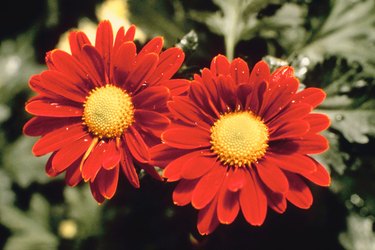
The chemical compounds in eucalyptus flowers, chrysanthemums, blossoms on hot pepper plants, and citrus flowers repel common household spiders. In fact, these chemicals are isolated and used in non-toxic insecticides, including sprays, candles and rubbing compounds. Understanding the benefits and the habits of spiders is the first step towards controlling them in the home and garden environment.
Benefits
Video of the Day
Spiders are included as beneficial insects in sustainable, organic gardening. They are members of the Arachnida class. They have two body parts rather than the three that insects have. Spiders act as biological controls for unwanted, harmful insect pests that eat food crops and ornamental plants. Spiders consume more harmful insect pests than any other group of predators, according to the University of Maine Integrated Pest Management program.
Video of the Day
Chrysanthemum
Pyrethrum powder and spray are used as an all-purpose insecticide for spiders, mites and other microscopic insects. It is made from flowers of the Dalmatian and Persian species of chrysanthemum. The Dalmatian chrysanthemum (T. cinerariifolium) resembles the common Shasta daisy and is indigenous to the Dalmatia region of Croatia. Persian chrysanthemums (C. coccineum) produce bright pink, white or red flowers and lacey green leaves.Their pyrethum content is less significant than the Dalmatian chrysanthemums.
Hedgeapples
Fruit of the Osage orange tree develop after its flowers have blossomed. They are large, round and light green with a bumpy skin. They are often called hedgeapples because the tree is has traditionally been used as a boundary hedge in ranch land. Homeowners put hedgeapples in the corners of a room, the basement and perimeter around the house to repel spiders. Belief of their spider-repelling capabilities is anecdotal and not yet confirmed by research.
Botanicals
Chemical compounds in hot peppers, eucalyptus, garlic and citrus are extracted to make non-toxic insect repellents. Non-toxic spider and insect repellents are available at natural foods stores and online natural pest control product websites. These plants are also used in the garden as part of a program of biological diversity to keep insects in a beneficial balance. Less than one percent of insects in the garden are harmful, according to Cornell University.
- University of Maine Extension; Beneficial Insects & Spiders in Your Maine Backyard; Colin Stewart; 2004
- Cornell University Extension; Companion Planting; Beyfuss, et al.; 1994
- Colorado State University Extension; Common Garden Spiders; Linda S. Raynor
- University of California at Davis Online IPM; Spider Management; R.S. Vetter; Nov. 2007
- Clemson University Extension; Less Toxic Insecticides; Karen Russ; August, 2005
- International Center for Pyrethrum Research;
- North Carolina State University Extension;Alice B. Russell;
- University of Kentucky Extension; Eliminating Spiders Around Homes & Buildings; Mike Potter; Nov. 1997
- Infonet Biovision; Plant Extract- Pyrethrum
- Iowa State University; Horticulture & Home Pest News; Hedgeapples; Richard Jouran; Oct. 1997